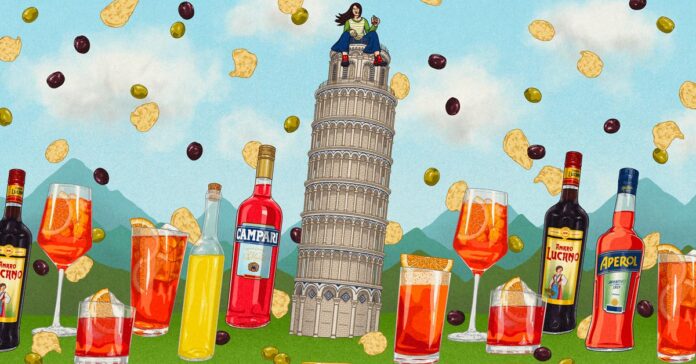A question Gianna Johns thought more people would ask her is, What the hell is “Italian Tajín?” At Baby Gee, her bar in Long Beach, California, the housemade powder rims the nonalcoholic Dew Dropper—made with kumquat-infused verjus, tonic and Ritual tequila alternative—as well as the Kooks Only, a Margarita variation.
Baby Gee’s staff is prepared for the question: It’s lemon powder (made from any extra lemons that were cut for garnish), fennel seed, rosemary, crushed chile flakes and salt. The blend channels the sour, spicy and salty building blocks of Tajín, the beloved all-purpose Mexican chile seasoning, “but with Italian botanicals,” says Johns—who is herself Mexican and Italian, and often calls on the nostalgic flavors of her upbringing when creating drinks. “A lot of the time, I naturally end up with something that’s a little bit Mexican, and also a little bit Italian,” she says.
That Johns’ guests are unfazed by the concept of Italian Tajín is a reflection of a larger trend that’s permeating our drinking culture: the Italian-ification of everything. This appears in the form of “aperitiki,” an “Italian G&T” and even a new Nashville cocktail bar that bills itself as offering “cowboy culture” through an “Italian lens.” Brooklyn’s Spuyten Duyvil, an early figurehead in New York City’s rare-brew scene, spent its 20th year transforming itself into an amaro destination—a testament to the ascendance of Italy and the oversaturation of craft beer. But even Spuyten Duyvil owner Joe Carroll once acknowledged that “amaro will never be as big as beer.” So then, why is Italy everything everywhere all at once?
“Contemporary Italian food—not necessarily Italian American food—is rapidly becoming the de facto high-quality food whether you’re in the United States or in Europe, really displacing traditional French as haute cuisine,” says Ian MacAllen, author of Red Sauce: How Italian Food Became American. Regional Italian food, whether it’s wild boar ragù from Bologna, gnocco fritto from Modena or pasta alla norma from Sicily, has become a sort of shorthand for “sophisticated and authentic” among American diners. There’s a sense of trust in the idea of Italian food, and this crosses over to drinks as well. MacAllen also notes that people are drawn to “collecting” experiences, and an Italian product such as amaro, with its hundreds of variations, “really lends itself to that.”
Naturally, marketing helps, MacAllen adds, pointing to the prevalence of Aperol Spritzes stateside. “You can’t separate the marketing ability of a big conglomerate taking a local spirit, or a local liqueur like Aperol, and putting money behind it,” he says. Aperol’s U.S. promotion of the product through popular summer events worked: Today, Aperol Spritzes are synonymous with summer and the fantasy of dream Italian vacations. If Italy is the travel destination, of course drinkers will be drawn to anything that feels like a facsimile of the real deal.
Perhaps inevitably, we’ve come full circle. Now, even Italian American—the original-sin fusion cooking that “authentic,” hyperregional Italian restaurants were supposed to rectify—is back in vogue. For Four Walls, the Nashville cocktail bar, having elements of cowboy culture felt obvious. The bar is located within The Joseph, a luxury hotel that houses the Italian restaurant Yolan, and both are named for and inspired by owners the Pizzuti family. An Italian touch to the American cowboy vibe seemed like a fitting familial homage, but it also addressed an “untapped” segment of the city’s tiki- and speakeasy-heavy drinking scene, according to Kenneth Vanhooser, who worked as Four Walls’ consulting menu designer.
The approach plays out on a flavor level in drinks like the Gentleman Jim, a Manhattan made with rye whiskey (“a cowboy classic”) and two Italian vermouths, or the Sergio Leone, which includes a blend of bourbons, plus Aperol and maraschino house bitters. “Southern hospitality is mirrored in Italian hospitality,” Vanhooser says. An on-the-nose nod to the concept: Spaghetti Westerns, like the ones popularized by Italian director Sergio Leone, play on screens throughout the bar. During that era of filmmaking, directors like Leone made movies in Italy (and Spain) that portrayed the United States; now we’re drinking in the United States while dreaming of Italy.



